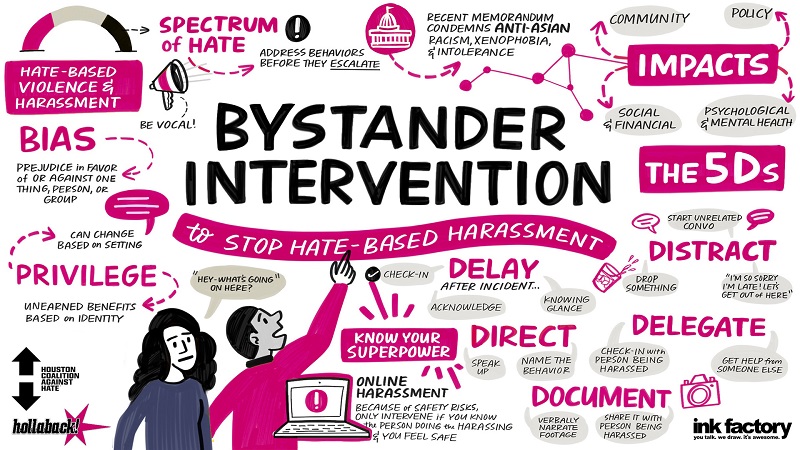
While we did not come up with the concept of the Five Ds ourselves, we consider it vital to include it in this presentation. The Five Ds represent a way for the layperson to intervene when harassment occurs, whether in the workplace, public, or any other circumstance related to harassment and discrimination. Each of these Five D’s is described in more detail below.
Delay: Delay refers to acknowledging the victim after the harassment has occurred. You can use Delay by offering your support, asking them how they are and if they are okay, and using caring, open body language.
Distract: Distract refers to drawing attention away from the harassing behavior to attempt to get the harasser to stop. Distract could be used in numerous ways depending on your comfort level, but a few examples are to ask the harasser or victim an unrelated question, such as where a nearby location is or another simple question, or making a disruptive noise.
Direct: Direct refers to confronting the harasser when the behavior occurs. In contrast to Distract, Direct is more targeted. You can use Distract by speaking up to the harasser, perhaps by stating, “That’s not okay,” or a similar statement.
Delegate: Delegate refers to enlisting the help of others to end the behavior that is occurring. Delegate is especially helpful in situations where you do not feel comfortable acting alone. For example, you can use Delegate by asking another person to “back you up” when you engage in another one of the Ds.
Document: The final D, Document, refers to recording or otherwise making a “paper trail” of the behavior to be proven later. Document should always be used in tandem with another strategy if you feel comfortable doing so. A few ways to use Document are recording the behavior on your phone or taking notes. However, the most important part of Document is to share it with the victim and let them decide what to do with it, whether that be turning it over to law enforcement, posting on social media, and so on.
Practice
You are riding the subway home after a long, difficult day at work. The subway train is mostly comprised of people who are White. One man stands up and walks over to a Latinx person speaking Spanish with a friend and begins to tell them to “go back to their own country,” among other things. What would you do?